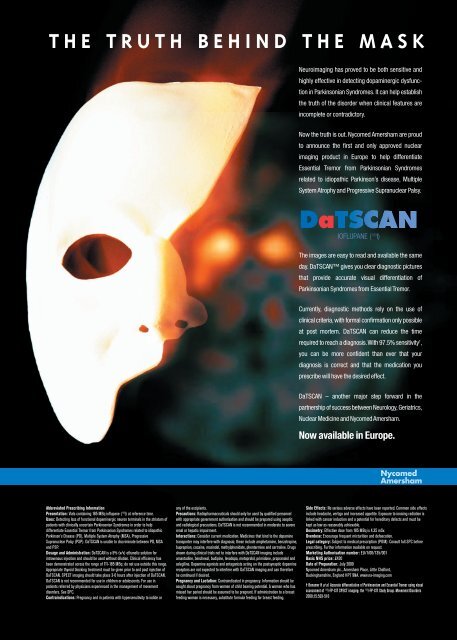World Congress of Neurology - ACNR
World Congress of Neurology - ACNR
World Congress of Neurology - ACNR
Create successful ePaper yourself
Turn your PDF publications into a flip-book with our unique Google optimized e-Paper software.
THE TRUTH BEHIND THE MASK<br />
Neuroimaging has proved to be both sensitive and<br />
highly effective in detecting dopaminergic dysfunction<br />
in Parkinsonian Syndromes. It can help establish<br />
the truth <strong>of</strong> the disorder when clinical features are<br />
incomplete or contradictory.<br />
Now the truth is out. Nycomed Amersham are proud<br />
to announce the first and only approved nuclear<br />
imaging product in Europe to help differentiate<br />
Essential Tremor from Parkinsonian Syndromes<br />
related to idiopathic Parkinson’s disease, Multiple<br />
System Atrophy and Progressive Supranuclear Palsy.<br />
IOFLUPANE ( 123 I)<br />
The images are easy to read and available the same<br />
day. DaTSCAN gives you clear diagnostic pictures<br />
that provide accurate visual differentiation <strong>of</strong><br />
Parkinsonian Syndromes from Essential Tremor.<br />
Currently, diagnostic methods rely on the use <strong>of</strong><br />
clinical criteria,with formal confirmation only possible<br />
at post mortem. DaTSCAN can reduce the time<br />
required to reach a diagnosis.With 97.5% sensitivity † ,<br />
you can be more confident than ever that your<br />
diagnosis is correct and that the medication you<br />
prescribe will have the desired effect.<br />
DaTSCAN – another major step forward in the<br />
partnership <strong>of</strong> success between <strong>Neurology</strong>,Geriatrics,<br />
Nuclear Medicine and Nycomed Amersham.<br />
Now available in Europe.<br />
Abbreviated Prescribing Information<br />
Presentation: Vials containing 185 MBq i<strong>of</strong>lupane ( 123 I) at reference time.<br />
Uses: Detecting loss <strong>of</strong> functional dopaminergic neuron terminals in the striatum <strong>of</strong><br />
patients with clinically uncertain Parkinsonian Syndromes in order to help<br />
differentiate Essential Tremor from Parkinsonian Syndromes related to idiopathic<br />
Parkinson’s Disease (PD), Multiple System Atrophy (MSA), Progressive<br />
Supranuclear Palsy (PSP). DaTSCAN is unable to discriminate between PD, MSA<br />
and PSP.<br />
Dosage and Administration: DaTSCAN is a 5% (v/v) ethanolic solution for<br />
intravenous injection and should be used without dilution. Clinical efficiency has<br />
been demonstrated across the range <strong>of</strong> 111-185 MBq; do not use outside this range.<br />
Appropriate thyroid blocking treatment must be given prior to and post injection <strong>of</strong><br />
DaTSCAN. SPECT imaging should take place 3-6 hours after injection <strong>of</strong> DaTSCAN.<br />
DaTSCAN is not recommended for use in children or adolescents. For use in<br />
patients referred by physicians experienced in the management <strong>of</strong> movement<br />
disorders. See SPC.<br />
Contraindications: Pregnancy and in patients with hypersensitivity to iodide or<br />
any <strong>of</strong> the excipients.<br />
Precautions: Radiopharmaceuticals should only be used by qualified personnel<br />
with appropriate government authorisation and should be prepared using aseptic<br />
and radiological precautions. DaTSCAN is not recommended in moderate to severe<br />
renal or hepatic impairment.<br />
Interactions: Consider current medication. Medicines that bind to the dopamine<br />
transporter may interfere with diagnosis; these include amphetamine, benzotropine,<br />
buproprion, cocaine, mazindol, methylphenidate, phentermine and sertraline. Drugs<br />
shown during clinical trials not to interfere with DaTSCAN imaging include<br />
amantadine, benzhexol, budipine, levodopa, metoprolol, primidone, propranolol and<br />
selegiline. Dopamine agonists and antagonists acting on the postsynaptic dopamine<br />
receptors are not expected to interfere with DaTSCAN imaging and can therefore<br />
be continued if desired.<br />
Pregnancy and Lactation: Contraindicated in pregnancy. Information should be<br />
sought about pregnancy from women <strong>of</strong> child bearing potential. A woman who has<br />
missed her period should be assumed to be pregnant. If administration to a breast<br />
feeding woman is necessary, substitute formula feeding for breast feeding.<br />
Side Effects: No serious adverse effects have been reported. Common side effects<br />
include headache, vertigo and increased appetite. Exposure to ionising radiation is<br />
linked with cancer induction and a potential for hereditary defects and must be<br />
kept as low as reasonably achievable.<br />
Dosimetry: Effective dose from 185 MBq is 4.35 mSv.<br />
Overdose: Encourage frequent micturition and defaecation.<br />
Legal category: Subject to medical prescription (POM). Consult full SPC before<br />
prescribing. Further information available on request.<br />
Marketing Authorisation number: EU/1/00/135/001<br />
Basic NHS price: £420<br />
Date <strong>of</strong> Preparation: July 2000<br />
Nycomed Amersham plc., Amersham Place, Little Chalfont,<br />
Buckinghamshire, England HP7 9NA. www.na-imaging.com<br />
† Benamer H et al. Accurate differentiation <strong>of</strong> Parkinsonism and Essential Tremor using visual<br />
assessment <strong>of</strong> 123 I-FP-CIT SPECT imaging: the 123 I-FP-CIT Study Group. Movement Disorders<br />
2000;15:503-510

















